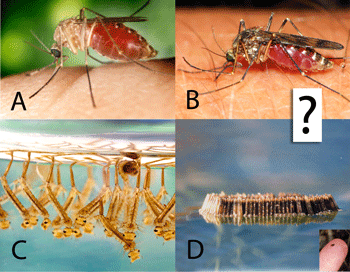 Biting insects transmit human and animal diseases, including protozoan (e.g., malaria, leishmania, trypanosoma (sleeping sickness, Chagas disease)), filiarial (e.g., onchocerciasis, Guinea worm), and viral (e.g., yellow fever, West Nile, dengue) diseases. Control measures rely on identifying the insects, which generally requires expert training.
Biting insects transmit human and animal diseases, including protozoan (e.g., malaria, leishmania, trypanosoma (sleeping sickness, Chagas disease)), filiarial (e.g., onchocerciasis, Guinea worm), and viral (e.g., yellow fever, West Nile, dengue) diseases. Control measures rely on identifying the insects, which generally requires expert training.
There are 174 mosquito species and subspecies in North America (“Identification and Geographical Distribution of the Mosquitos of North America, North of Mexico,” Richard F. Darsie, Jr. and Ronald A. Ward, University Press of Florida, 2005). Many species bite humans, but only a handful are important disease vectors. It takes an expert to identify Culex pipiens (panel A), which is the major vector for West Nile virus in eastern U.S., and to distinguish this from other species, for example, Culiseta incidens (panel B), which does not transmit human disease. Even experts are challenged by larvae (C), and eggs (D), and the latter are small and easily overlooked (egg raft size shown in inset). Planning and/or applying control measures is best done before adults hatch, but the early stages are what is most difficult.
The reference work cited above includes morphologic keys for identification of adult females and fourth-instar larvae. However, only an expert could make use of these (e.g. “lower mesepimeral setae absent, pale basal band on abdominal tergum II narrowed, or completely interrupted, medially). If mosquito identification is important for society, then reference DNA barcodes are what is needed, as these enable many more persons to name specimens, regardless of life stage. It does not make sense to rely on reference works for the world’s mosquitos that are incomprehensible to anyone who is not already a mosquito specialist.
The information on the number of species of mosquito and the need to distinguish them is very useful, both at cognitive and practical levels. It is one more instance of interface between science and human society in the area of public health.